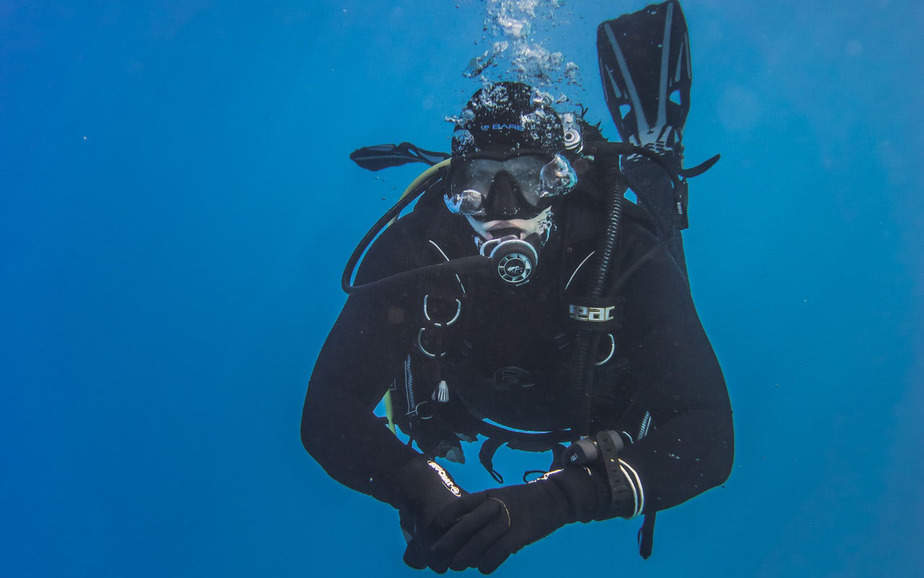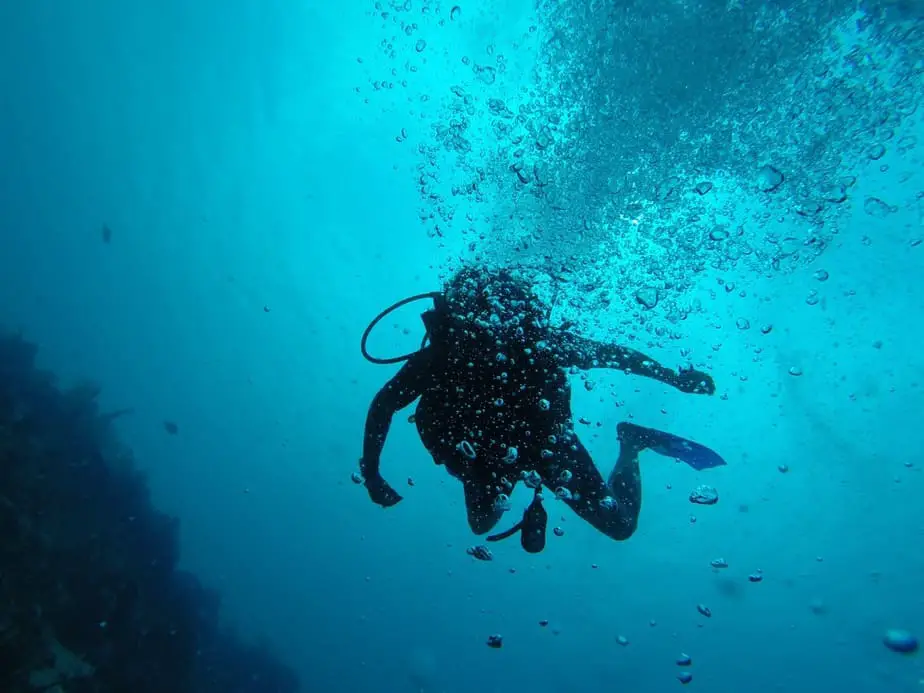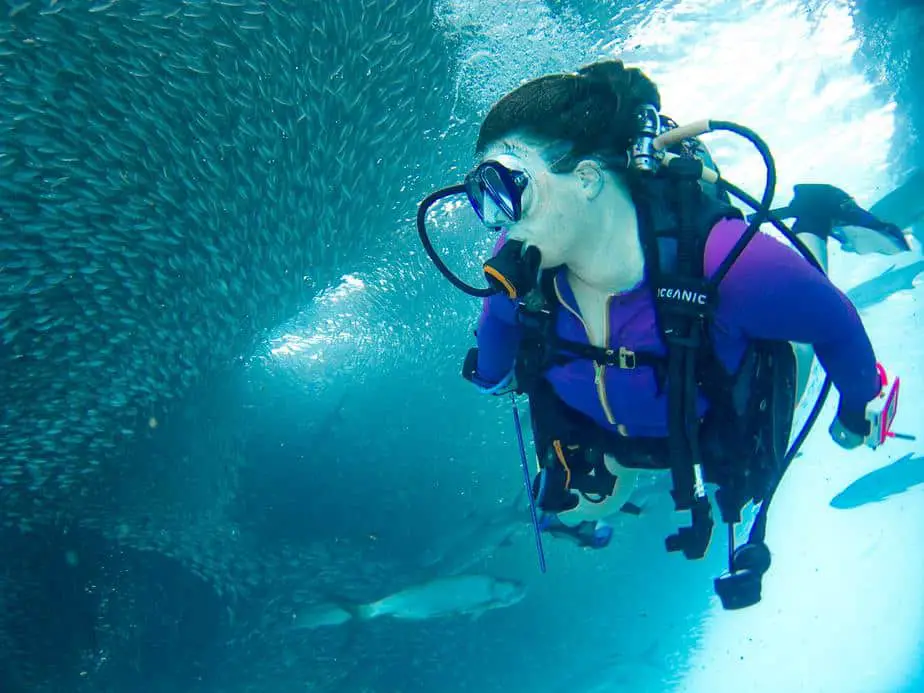In order to breathe underwater, you need to breathe gas from a gas cylinder. When you’re just starting out, the gas mixture will just be ordinary air. As you get more experience, you can breathe other gases from your scuba cylinder, and nitrox is the most popular. But what is nitrox and how does it help you?
Enriched Air Nitrox (EAN), Oxygen Enriched Air, or simply nitrox, all refer to the same gas mixture. Basically, regular air has a composition of 21% oxygen, 78% nitrogen, and 1% other gases. When you’re doing a nitrox dive, you are breathing a gas mix that has more than the standard 21% oxygen. Depending on the type of diving you’re doing, you may use a gas mix with higher oxygen levels than usual.
Can anybody dive with nitrox?
Diving with nitrox requires special training, otherwise it can pose a serious threat to your health if you’re not aware of the risks. Yes, humans need to breathe oxygen in order to survive, but there is such a thing as having too much oxygen. Therefore, you cannot use an EAN cylinder unless you are certified to do so.
What makes nitrox dangerous? The gas in your scuba tank is highly compressed. While diving, you are breathing this gas under increased pressure, and your body will absorb more gas than usual. When you breathe a gas with a high concentration of oxygen for a long time, you can experience oxygen toxicity which can be life-threatening.
As a result, all diving cylinders that contain anything other than standard air must be marked. Remember that you should only use equipment that you are certified to use. Just because some advanced scuba equipment can be found on the boat doesn’t mean you are allowed to use it. The boat operator/instructor will ask to see your certification and will only let you use nitrox tanks if you’re qualified to do so.
Benefits of diving with nitrox

You may have had a more experienced diver encourage you to try diving nitrox. Why, you might be wondering? There is a common misconception that nitrox can help you dive deeper, but the reality is that nitrox helps you dive for longer. If you want to dive deeper, you’ll want to dive with trimix.
Another myth is that using nitrox will make you feel less tired after doing multiple dives. There is no data to prove this, but for some reason people started spreading this idea. Our theory for this phenomenon is that when divers are diving on holiday, they are just naturally excited and feel like they want to make the most of their trip. We think their energy levels don’t have anything to do with nitrox and they are just riding the high of being on vacation.
Ok, so nitrox can help you dive for longer. What exactly is happening in your body? If you remember your first lessons, you learned that there are time and depth limits to diving. The reason is that your body will absorb the gas that you’re breathing, and since you’re under pressure, more of it is absorbed into your system compared to at the surface.
Absorbing too much gas becomes an issue when you ascend because your body will rapidly “off-gas”, allowing bubbles to form too quickly and resulting in decompression sickness. Since your body will use up the oxygen, the gas that is being absorbed into your body is mostly nitrogen. Is there any way to absorb less nitrogen? Yes, there is.
With all of this in mind, the idea behind enriched air nitrox is that you can reduce the amount of nitrogen by increasing the amount of oxygen in the gas mix (greater than the usual 21% found in regular air). Your body can also benefit from the extra oxygen by gaining more energy. Furthermore, the reduced nitrogen content means less gets absorbed and your body doesn’t have to work as hard to get rid of the excess.
Since you are breathing and absorbing less nitrogen than standard air, the net effect is that you will take longer to reach your no-decompression limit, meaning you will have a longer bottom time.
Risks of using nitrox
After reading about the benefits of nitrox, it sounds like a no-brainer; why doesn’t everyone dive nitrox? Unfortunately, there are some drawbacks which is why there is even a special course for it. As we mentioned above, your body will absorb more gases compared to the surface when it’s under pressure.
Furthermore, the gases themselves will react quicker as well. It’s not a problem from nitrogen since the body doesn’t use it; the problem stems from oxygen which our body does use. These faster reactions become an issue and it’s worsened by the fact that more oxygen is available in each breath due to the higher oxygen content in nitrox. If you are not careful, you can suffer the effects of oxygen toxicity.
By taking the nitrox course, you will learn the relationship between pressure, gas absorption, and why limits are necessary. This course is useful if you want to dive for longer, and it’s absolutely necessary if you plan on taking on a leadership role (e.g. Divemaster).
What types of nitrox gas is used for recreational diving?
By PADI standards, the maximum oxygen content allowed in a breathing mix is 40%. This limit only applies to recreational divers. You will first need to get an Enriched Air Nitrox Diver certification which qualifies you to dive nitrox. You can finish this course in a couple of days.
After completing it, you’ll get a nitro diver license. You are now qualified to dive using enriched air with oxygen content between 22% to 40%. In reality, you will most likely use EAN32 (Nitrox I) and EAN 36 (Nitrox II). These are the most popular gas mixes among recreational divers due to their availability and affordability.
It is worth mentioning that these are not the only nitrox mixes used in diving. There are several distinctions between the types of enriched air:
- Hypoxic – This is a nitrox mix that has less oxygen than air (i.e. oxygen percentage less than 21%).
- Normoxic – This is the technical name for regular air where the oxygen content is 21%.
- Hyperoxic – This is enriched air where the percentage of oxygen is greater than 21%. Enriched air is further categorized into “hot nitrox” and “cold nitrox.”
Cold nitrox is a gas mix where the oxygen content is within the range of 21% to 40%, i.e. the range for recreational divers. Most regulators are compatible with such a mixture.
Hot nitrox is a gas mix from 40% to 100% oxygen and is used by technical divers to perform decompression. When using hot nitrox, the diver must make sure their equipment meets the aerobic purity requirements.
You can figure out what the oxygen percentage of your gas mix is by using an oxygen analyzer to make sure its readings match up with what the nitrox label says.
How deep can I dive using nitrox?

We’ve mentioned that nitrox helps you dive longer, not necessarily deeper. Each breathing mix has a maximum operational depth (MOD), which is how deep you can dive with the given breathing mix. MOD is a measurement in feet or meters where the partial pressure of oxygen (PpO2) reaches the maximum allowable value.
The MOD of the breathing gas is important to know for your safety because exceeding it can lead to oxygen poisoning. For recreational diving, the maximum permissible oxygen partial pressure is 1.4 ATA for recreational diving, and 1.6 ATA for decompression stops.
The partial pressure of oxygen on land is .21 ATA, which reflects the 21% oxygen in normal air multiplied by the atmospheric pressure. As you dive deeper, the atmospheric pressure increases which changes the partial pressure of oxygen. For instance, once you reach 10 m (33 feet), the atmospheric pressure has doubled. Thus, the partial pressure of oxygen rises to .42 if you are breathing air. This is also the point where oxygen starts to get toxic.
Clarifying on the last point, even though oxygen has started to technically become toxic at a depth of 10 m, you would have to stay underwater for such a long time that your gas cylinder would run out of air first.
The standard for the maximum safe value of partial pressure is 1.4 ATA. This level is reached when you dive down to a depth of 56 m (185 ft) breathing only air. This is where nitrox becomes an issue. Since there is a higher concentration of oxygen in nitrox, oxygen toxicity is more easily reached. The MOD of Nitrox II is only 28 m (94 ft)!
In other words, having a higher concentration of oxygen will actually backfire on you if your goal is to dive deeper. When diving nitrox at 38% oxygen, you will reach 1.4 ATA at only 26 m (87 ft).
In case you’re wondering how we got these numbers, you can calculate it yourself by taking the atmospheric pressure multiplied by the oxygen concentration. For instance, if you plan on diving at 132 feet using Nitrox I, the result is 5 ATM * 0.32 which is a PpO2 of 1.6. You can dive this deep, but since it’s higher than the recommended 1.4, you’ll require decompression stops to safely ascend.
When the partial pressure goes above 1.4 ATA, the result is deadly! This is because past this level, there is more oxygen in the body than the body can metabolize. The oxygen will either dissolve into the bloodstream or bond to hemoglobin. When the hemoglobin is no longer able to transport CO2 to the lungs, both CO2 and nitrogen will accumulate in the body. This results in decreased blood flow to the brain and eventually the central nervous system is affected as well.
The end result is you will experience convulsions, seizures, twitching, nausea, ear ringing, and more. To reiterate: nitrox does NOT allow you to dive deeper; quite the opposite in fact.
How do I know which tanks are filled with nitrox?
Even if you’re aware that you shouldn’t use nitrox without the proper certification, how exactly can you tell a regular tank from a nitrox tank? Simple. All diving cylinders that contain anything other than standard air will have a bright sticker that informs the diver of what exactly is contained inside. The sticker must be clear, large, and easily seen from all sides so it’s abundantly clear the tank contains enriched air.
Since nitrox is such a broad term which basically means the gas mix has different amounts of oxygen than the usual 21%, the label should tell you exactly what percentage it is. In fact, each EAN tank label should have the following information:
- Fill date: When the tank was filled.
- Oxygen %: The percentage of oxygen in the mixture.
- Bar/PSI: How much gas pressure is in the cylinder.
- Max depth: The maximum depth at which you can use the given mix.
- Analyzed by: Name of the person who analyzed the person after preparation.
- Diver: Your name if it’s your tank, otherwise the name of the diver who’ll use this mix.
As you can see, the label contains detailed information and even the names of the people involved with the tank for accountability reasons. This ensures that everything done is above board and done to a high standard, because no one wants to get in trouble. Regardless, each diver should be analyzing the gas in the tank just to be safe.
In order to analyze the gas mix, you must use an oxygen analyzer. This will tell you the exact percentage of oxygen of the gas mix inside the tank. Remember, you are responsible for analyzing the gas in your tank before each dive. At the end of the day, you will be the one diving with the tank so you should take control of your own safety and well-being.
Parting words
Now that you have a basic understanding of enriched air – how it is different from ordinary air and the benefits it provides, is it worth diving with nitrox? As long as you are using it for recreational diving (i.e., shallow depths), the reduced nitrogen content will let you stay underwater for longer. Getting an extra dozen or so minutes underwater might not seem like much, but that can represent a 20% increase in bottom time.
If you plan on vacationing in a tropical destination to dive, you’ll want to maximize your value by diving for as long as possible. This is where enriched air comes in handy. We highly recommend you take your Enriched Air Nitrox Diver course so that you can improve your diving experiences.


